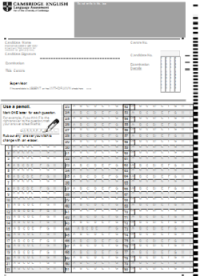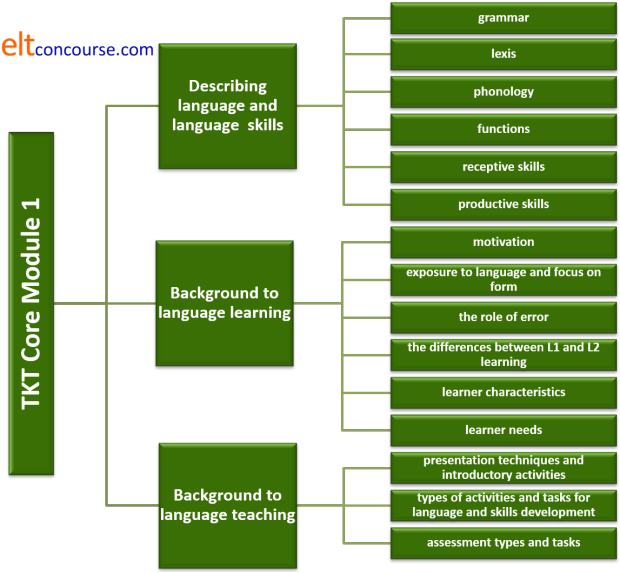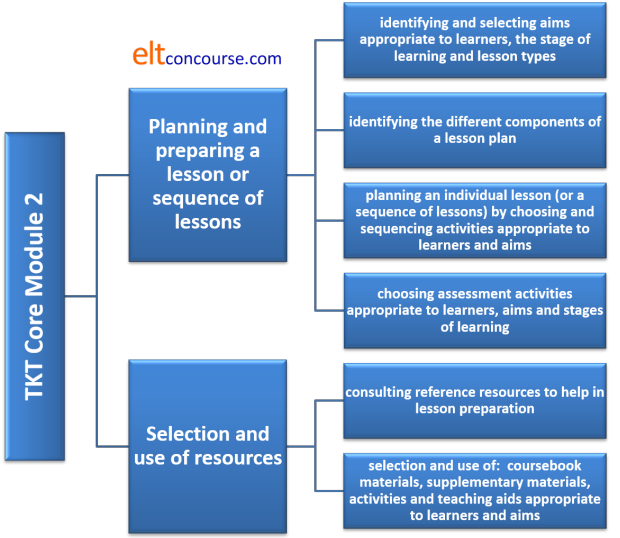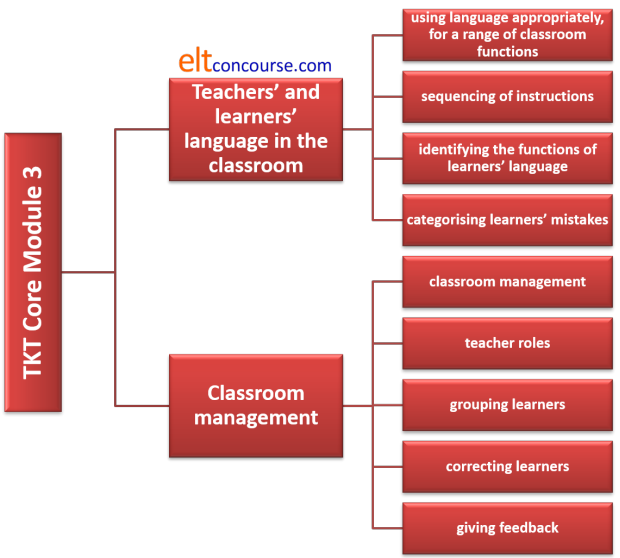The overview of Teaching Knowledge Test (TKT) Core Modules 1, 2 and 3
 |
Welcome to the free course |
This preparation course covers the three core modules of the Teaching Knowledge Test administered by the University of Cambridge. There is a free Study Companion to go with the work on the website. Get it in a new tab by clicking here.
You can, of course, simply use the practice exercises on
this site without following the course (or any course).
You
will then be wasting most of your time because testing yourself is
not the same as learning.
 |
What is TKT? |
TKT is a modular course which is assessed via a paper-based
examination. There is no practical teaching assessment.
As well as the course on this site, a large number of institutions
worldwide offer face-to-face courses to prepare you for the
examinations.
You are not obliged to take a face-to-face course to enter the
examinations. You can do that at any Cambridge Open Centre.
In Cambridge's own words:
TKT shows how you are developing as a
teacher. It is ideal for people who want to prove their teaching
knowledge with a globally recognised certificate.
With TKT, you show employers that you:
are familiar with different teaching methodologies
know how to use teaching resources effectively
understand key aspects of lesson planning
can use different classroom management methods for different needs.
Source:
https://www.cambridgeenglish.org/teaching-english/teaching-qualifications/tkt/
 |
The overview
This page contains the overview of the course and the TKT itself. From here, you can navigate to any other part of the
course or simply begin and follow where we lead. |
|||||||||||
|
On this page, and in the Study Companion, you will find information about:
|
||||||||||||
 |
What is in the three Modules?TKT has three core ModulesYou can click on the diagrams below to go to the index for the Module you want. |
 |
Module 1: Language and background to language learning and teaching |
 |
Module 2: Lesson planning and use of resources for language teaching |
 |
Module 3: Managing the teaching and learning process |
 |
How is TKT assessed?For each module there are 80 multiple-choice or matching
questions.
|
To come into Band 4, you will need 70 out of 80 possible
marks (87.5%). To come into band 3, you will need
45-50 marks out of 80 (56.25-62.5%).
We'll give you plenty of practice as we go along. Many
of the practice tests are based on the formats you will
find in the real examination.
Cambridge Assessment has a document on its website which
sets out in detail what each band means for each module.
You can get it from https://www.cambridgeenglish.org/Images/22185-tkt-band-descriptors.pdf.
 |
TKT pass rates |
Worldwide, the figures look like this*:
| Pass Band 4 | 10.5% |
| Pass Band 3 | 61.4% |
| Pass Band 2 | 23.6% |
| Pass Band 1 | 1.7% |
You should be aiming for at least Band 3 and this course is intended to help you do even better than that.
Pass rates around the world are very variable. For example, in Switzerland, over 83% achieved Band 4, but in Thailand nobody did.
 |
Examination tips |
Before the examination:
- As you work through this guide, make
a note of any words and expressions which are new to you.
Keep a separate notebook for this.
Check through the Teaching Knowledge Test glossary (see the link below) and make sure you understand all the words.
If you are working with a colleague, test each other. - Go back to each of the guides in the Module and do the practice tests at the end again.
During the examination:
- Remember that all the questions are worth the same:
1 mark.
Don't spend a lot of time on any single item. If you don't know, move on.
Do not spend more than one minute on each item. - Read the instructions carefully.
- For some tests, you must find the WRONG answer. Always read the instruction!
- In matching tests there is usually one item extra which you do not need to use.
- In some matching tests you have 7 or 8 things and only 3 or 4 items to match so you need to use some items more than once.
- Tick them off as you go so you know what's left. It's much easier that way.
- If the answer contains exactly the same words as in the question, it is probably the wrong answer!
 |
How do I use this course? |
 |
Should I follow the guides in order? |
Yes. If you are new to TKT, follow the guides in order
starting with the beginning of Module 1 (grammar) and finishing at
the end of Module 3 (giving feedback).
Each part of the course is written on the basis that you have
followed the previous parts.
If you are coming to this guide for some extra work and revision,
you can take the guides in any order.
 |
What if I don't understand something? |
You can:
- Repeat the guide.
- Use the link below to Search ELT Concourse to find more guides to the area that puzzles you.
- Ask a question. This is a free course so you don't have immediate tutor support but you can use the contact link from the left-hand menu on every page to ask a question. If lots of people ask the same question, we'll try to answer it.
 |
What equipment do I need? |
You'll need to read and take notes in many of the guides because
they have tasks for you to complete. If you do not do the
tasks, you will not learn as much or engage with the materials.
A printer will be helpful for some guides but you do not need one.
 |
How much time do I need? |
If you pay for a TKT course, whether it is online or face to
face, you will find that most are around 50 to 60 hours of study
time plus some private study, reading and a little research.
Some are much shorter (as little as 30 hours in some cases) and some
are a little longer. Of course, many schools call 45 minutes
an hour of study time!
It is difficult to say how much time you will need because people
work at different speeds and have different background knowledge and
experience but, overall, you should commit to the following (more or
less):
- For Module 1
There are 16 Units in the course and you should, on average, spend about 90 minutes on each one, including the tests you do at the end of each unit and as you go along.
That's a total of around 24 hours but you should also give yourself about 8 hours to work through all the tests again and take the revision course when you have finished (or think you have). - For module 2
There are 6 Units in the course and, again, you should, on average, spend about 90 minutes on each one, including the tests you do at the end of each unit and as you go along.
That's a total of around 9 or 10 hours but you should also give yourself about 3 or 4 hours to work through all the tests again and take the revision course when you have finished (or think you have). - For Module 3
There are 9 Units in the course and, again, you should, on average, spend about 90 minutes on each one, including the tests you do at the end of each unit and as you go along.
That's a total of around 13 or 14 hours but you should also give yourself about 4 or 5 hours to work through all the tests again and take the revision course when you have finished (or think you have).
In total, therefore, you should be able to complete the course in
about 60 to 70 hours and that will give you time to do the tests
again and take the revision courses.
So:
- If you are working part-time on the course and give yourself 6 to 8 hours of study time a week, you will need around 10 weeks to finish the whole course for all three modules.
- If you are working more intensively and can give 25 hours a week to studying, you can finish the whole course in less than three weeks or so.
 |
What level of English do I need? |
Most paid-for courses ask that your level of English is at B2 on
the Common European Framework which is more or less around level 5.5
on the IELTS scoring system. The Cambridge First Certificate
in English (FCE) is at this level.
This describes an independent user of the language and means that
you:
- Can understand the main ideas of complex text on both concrete and abstract topics, including technical discussions in your field of specialisation.
- Can interact with a degree of fluency and spontaneity that makes regular interaction with native speakers quite possible without strain for either party.
- Can produce clear, detailed text on a wide range of subjects and explain a viewpoint on a topical issue giving the advantages and disadvantages of various options.
Because this is not a taught course, you do not need to interact with colleagues and tutors and time may not be pressing, so you may be able to follow the course successfully even if you are at B1 level. Below that, you probably do not have enough English to understand the materials.
 |
What resources do I need? |
If you follow this course carefully and also read other guides on
this site which are linked to it, you will have everything you need
to pass TKT. No further reference materials or
activities are needed.
You may find the Study Companion helpful.
That does not, of course,
constitute a guarantee!
In addition:
| The TKT course Study Companion | This booklet includes some of this introduction and self-test questions (with a key) for each Module of the TKT. |
| The TKT Glossary (new tab) | This is a list of terms and concepts useful for TKT on the Cambridge website. Download it before you start and refer to it as you go along. |
| The TKT Glossary crosswords | A set of 15 crossword puzzles to test you on the words in the glossary. |
| A grammar glossary (new tab) | This is a list of essential grammatical terms with definitions and examples. |
| A methodology glossary (new tab) | This is a list of essential methodological terminology. |
| Glossaries on this site (new tab) | This takes you to the list of all glossaries on this site some of which are much fuller and more advanced. |
| Cambridge English TKT | The general information page for TKT on the Cambridge site. |
| A 10-unit course in language analysis | This course covers the elements of pronunciation, lexis, subjects and objects, tenses and aspects, modality, sentences, phrases, clauses and text structures. |
| The index page for initial training | This section contains guides to language, skills, theory and more for less experienced or inexperienced teachers. |
| The index page for more experienced teachers | This section contains guides to language, skills, theory and more for more experienced teachers. |
| Search this site | Use this link if you are looking for something special. |
| The A-Z index | This is a list of all the training subjects on this site. |
| Learn to transcribe | This is a course to help you learn how to transcribe the sounds of English. |
 |
How do I revise? |
The really simple way is to do the course again.
The other ways are to follow these links.
|
There are short revision courses for all
three Modules. Do not do these until you have followed the course for the Module. |
||
| Module 1 revision | Module 2 revision | Module 3 revision |
|
You can repeat all the tests and exercises
in each Module. Do not do this before you have finished the course for the Module |
||
| Module 1 tests | Module 2 tests | Module 3 tests |
| When you have done the course and the tests, including the ones in the Study Companion, try a full practice examination. | ||
| Module 1 practice examination | Module 2 practice examination | Module 3 practice examination |
| If you like, you can also test yourself on the words in the glossary with: | The TKT glossary crossword puzzles | |
 |
To start your course |
|
| Click on the diagrams above or use this menu: | ||
| Module 1 Course | Module 2 Course | Module 3 Course |
| The Study Companion | ||
Good luck with the course!
If you have any comments and suggestions, please send them to ELT Concourse using the Feedback link on the left.
*Source: https://www.cambridgeenglish.org/research-and-validation/quality-and-accountability/grade-statistics/2018



